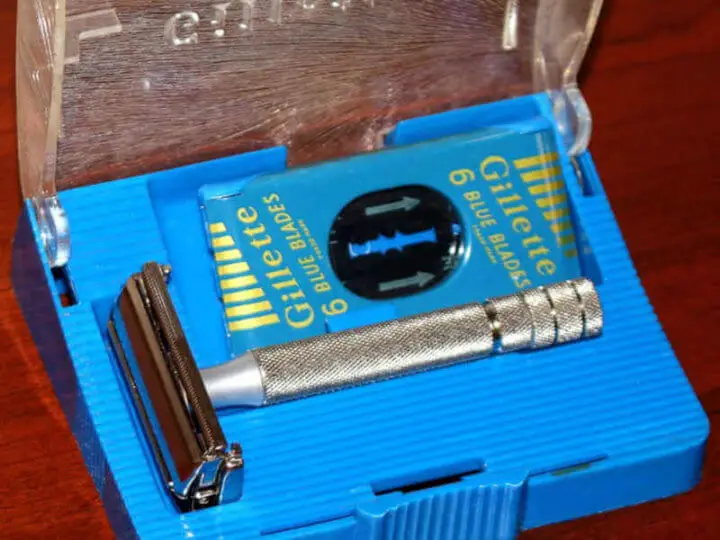
What is the best butterfly safety razor? The butterfly (AKA twist to open–TTO–AKA silo missile doors) double edge razor was the “state of the art” just prior to the introduction of cartridge razors. Since then that technology seems to have taken a back seat to less convenient, but easier to manufacture, technology. It’s been my long-held belief that we need to re-visit the butterfly razor. Are there any good “modern” butterfly razors? This is an updated article!
New Butterfly Twist To Open Razors Available Now
Unfortunately many butterfly safety razors produced these days do not have the best reputation. Most are made in China or Pakistan using an early 1960’s Gillette Super Speed design (the Gillette patents have long-since expired) but often with sub-standard materials and workmanship. A quick search on Alibaba or AliExpress will find many examples.
But that is not to say all these razors are sub-standard. There are some good ones out there! Personally, I think the key indicator seems to be how involved the brand is with the manufacturing process. Those who merely place an order with an original equipment manufacturer (OEM) at the lowest price possible and wait for delivery will most likely get an inferior, inconsistent product.
Brands that take an active part in ensuring that agreed-upon design and quality control specifications are being followed–or do the manufacturing themselves–are more likely to have a more successful product, albeit at a slightly higher cost. That means multiple, regular trips to the factory in person. I hear this again and again from brand representatives who are “in the know.”
Brand names with time in the market can be another indicator of a better product (or at least an evolving product), though by no means a consistently accurate one.
Competitors For The Best Butterfly Safety Razor
(Amazon links are affiliate.)
Names like Feather, Parker, and Weishi have been around a while and are probably well-known to the old school shave enthusiast. More recent names like Viking’s Blade have taken steps to improve their products, and a couple brands have jumped into the mix, too. Let’s take a closer look (in alphabetical order):
Feather
Although perhaps better known for their double edge blades, Feather offers two butterfly double edge razors, the model 800-1B (AKA the Feather “Popular”) and the new model DER-A (AKA the Feather “Adjustable”–though personally I would call it a semi-adjustable).

The Feather Popular razor razor is different from Feather’s other products. Feather is generally known as a premium brand and their prices generally wander toward the higher end of the spectrum. But the “Popular,” with it’s plastic handle, light weight, and comparatively low price is definitely a value product. The shave is generally regarded as on the mild side (though I think not as mild as their high-end Stainless Steel razor). The razor’s light weight gives some shavers trouble because they unconsciously apply more pressure, making irritation more likely.
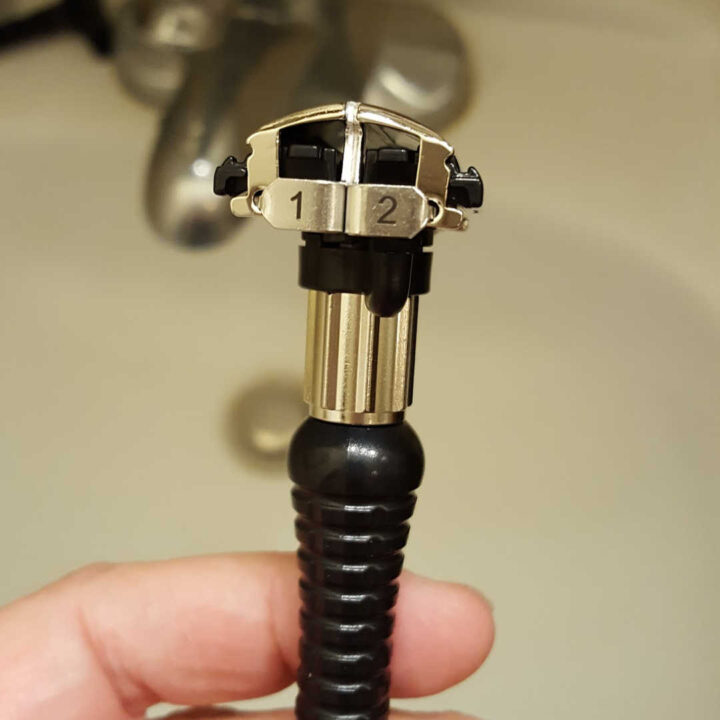
The “Adjustable” razor is adjustable but only in two positions: “1” for a very mild blade gap and “2” for a more middle-of-the-road shave. Like the “Popular” it has a plastic handle (and some plastic head parts), though I think the Adjustable’s handle is much more ergonomic.
As you might think, the mild Feather razors work well with the Feather high performance DE blades.
Parker
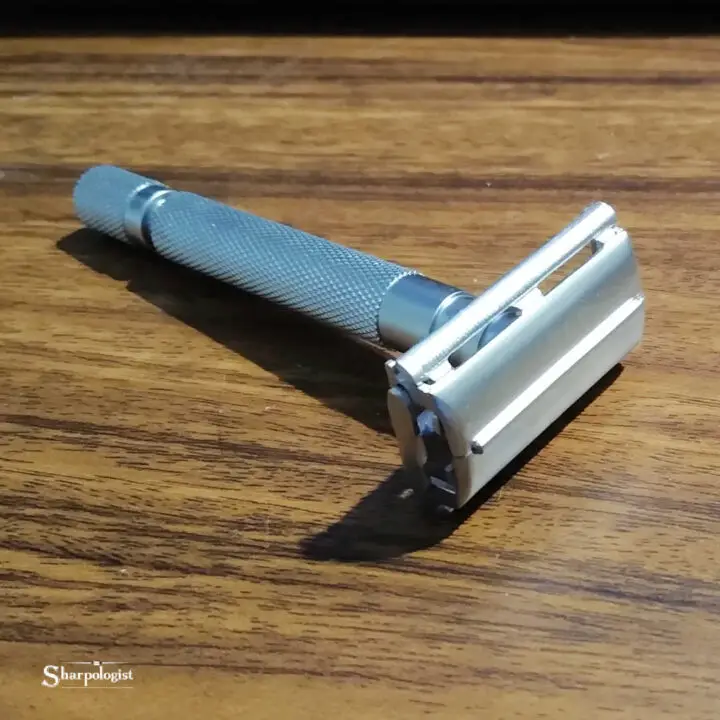
Parker Razors, founded in 1973 but launched in the US in 2005, now has a dozen models of butterfly razors, all sharing the same twist-to-open (TTO) head design. Some have slightly different TTO mechanics inside the handle of the razor, depending on whether the open.close dial is at the bottom or the top of the handle. Although best known as a “value” brand, the design and engineering of Parker razors have evolved and improved over the years (particularly after a major re-tooling in 2010) and I think they’re pretty solidly-made razors that are a bit more aggressive than the Parker three piece razors. The Parker 92R is a favorite razor of mine though the 99R is their most popular butterfly razor from a sales perspective.
Rockwell
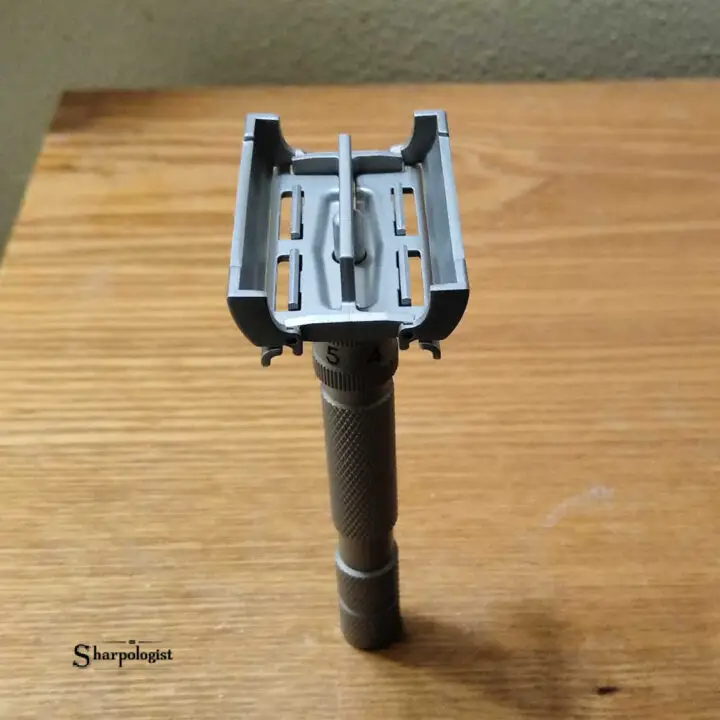
Although Rockwell Razors is more well known for their multi-base-plate 6S and 6C series–both are three-piece designs–their T2 adjustable safety razor uses a butterfly design.
Most twist-to-open mechanics need perhaps an additional quarter-turn on the open/close dial to “cinch down” after closing over a blade. The T2 cinches down much more securely, taking almost two full turns to clamp the blade completely. The T2’s dial action is very smooth and fluid-like.
I think the razor feels well-built and hefty with a good weight (albeit near the upper end of what I want as a comfortable weight) and balance. I find the handle length and texturing very good…I doubt this razor will ever easily slip through my fingers.
The adjustment dial is a bit tight for me to adjust with wet fingers, so adjusting a shave setting “on the fly” isn’t quite as convenient as some other adjustable razors, but certainly do-able. I generally keep the setting between “2” and “3” on the T2 for my shaves.
There is a fair amount of blade feel from the razor.
The head is on the larger side, which can make getting into tight spots (like under the nose) more of a challenge. But if you would be comfortable using something like a Merkur Futur razor you wouldn’t have any trouble with a Rockwell T2.
I find the standard T2 is built very well but I actually like the stainless steel T2 better–I think it shaves subtly better and is even better built (at a commensurately higher cost).
Viking’s Blade
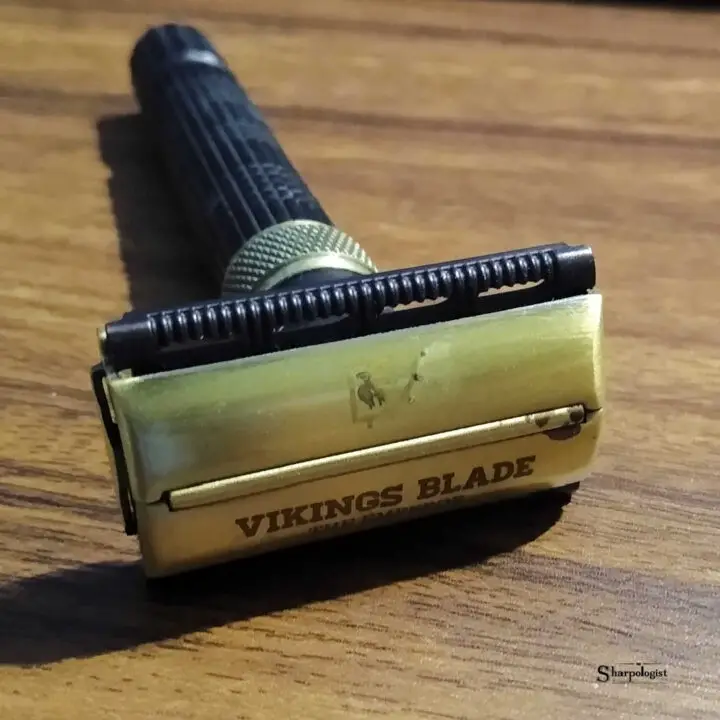
Although apparently a family-owned business since 1985 in Australia, Viking’s Blade was originally a “white label” contractor for other brands. In 2015 they added their own consumer-oriented online presence. After an early debacle with one of their suppliers Viking’s Blade as grown into a fairly significant presence in the wet shaving world (though some of the shaving Illuminati still seem to have a chip on their collective shoulder about them), mainly thanks to their use of Amazon as a marketing channel.
In 2017 the family business was acquired by an Intellectual Property (IP) and holding company named Vullion Group. I can’t find a whole lot about them but I will say that they do seem to be taking an active part in keeping an eye on their manufacturing partners (an important aspect, as I mentioned earlier). Their FAQ page includes this comment:
“We employ Australian supervisors and QC staff in Asia to ensure an enjoyable and ethical working environment that results the tightest error margin.”
Viking’s Blade currently have four butterfly razor lines: the original Chieftain, the long-handled Vulcan, the adjustable Crusader, and and the heavy-duty adjustable Emperor. There are also some model variations in the Chieftain line (which may have caused some additional confusion in the market) and Emperor line.
While it might be fair to say that some of their early razors bear a passing resemblance to other “copycat” razors I think Viking’s Blade’s latest offerings, particularly the Emperor adjustable razor, are clearly based on original designs and made to higher manufacturing specifications.
There have been reports of cosmetic issues on Emperor Augustus razors from some users (anodized coatings on handles wearing thin for example) but I haven’t seen any significant reports of mechanical problems.
Weishi
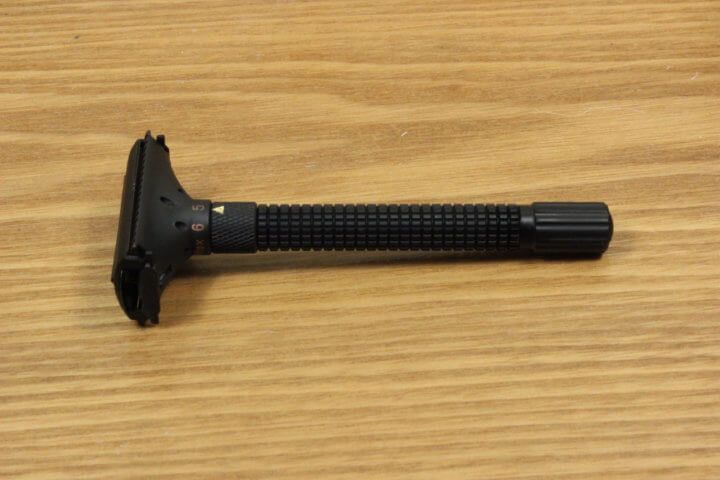
According to their Amazon storefront, Weishi has been manufacturing razors since 1993. They sell their own brand and I suspect they’re the OEM for a lot of others, too: razors from brands like Van Der Hagen, Micro Touch One, and Dorco (Prime) look an awful lot like the Weishi-branded model 9306 razor (which has itself gone through several minor revisions through the years, the latest being the 9306h).
Weishi is known as a low-cost alternative and their quality control had been kind of spotty but has improved over the last few years. And recently there seems to have been an effort to expand the variety of their double edge razor line with the “Nostalgic” series that includes both a long handle butterfly razor and an adjustable butterfly.
Background
Probably the first “one piece” safety razor was the Segal razor in the early 1930’s. The Segal razor did not open like the classic “butterfly” razor but rather the top cap pivoted to a vertical position and the blade (double edge but not the Gillette form factor) slid down the cap and onto the base plate.
Around the same time GEM produced the GEM Micromatic with a twist-to-open top. Of course it accepted GEM single-edge blades, not double edge blades.
The Twist To Open (TTO) “butterfly” razor was first introduced by Gillette in 1934 with the Gillette Aristocrat razor. Probably the best-known TTO razor, the Gillette Super Speed, was introduced in 1947 and by the late 1950’s had probably achieved the peak of its engineering design.
The Super Speed went through a number of tweaks, including another major redesign in 1966–notably adding a resin coating to a metal handle along with some cost-cutting changes.
Production of the Super Speed dropped off when cartridge razors started becoming profitable and halted in the United States altogether in 1988, though the razor was manufactured by Gillette in other parts of the world up until the new Millennium. Some manufacturing was done by third parties under license.
But the fact that many Super Speed razors can still be found in good condition at rummage sales, internet auction sites, antique stores, and your grandfather’s bathroom is a testament to its design, engineering, and durability.
Schick, Gillette’s perennial number two competitor and better known for their “Injector” razor, also produced a butterfly double edge razor: the Krona. Although only produced for a fairly short time in the mid-1960’s it has a reputation in the vintage razor enthusiast community as a razor that shaves well (personally, I think the Krona is a very under-appreciated razor).
Merkur took a stab at a TTO razor in the late 1990’s with their Vision razor. The Vision was not only a TTO design but an adjustable razor as well. It was a unique design but it was also ridiculously over-engineered (IMHO) and prone to failure unless it was regularly maintained. Merkur withdrew it from production in the early 2000’s.

Conclusion
Twist to open “butterfly” double edge razors are not only convenient to use but they also have a place in cultural history: ask a random person on the street to describe an “old fashioned safety razor” and the odds are they’ll say something like ‘oh, that razor where the top doors opened up to change a blade with.’ With the right kind of razor blade storage magazine blade changing can be a completely hands-off process.
Although not as common as they once were I think butterfly razors from Parker and recent models from Rockwell are well built, reasonably priced (comparable to other types of double edge razors), and deserving of consideration.
Do you have a butterfly razor? What do you think of it? Leave a comment below.

I own three. A J3 Super Speed, a Van der Hagen and a Parker 99R. The SS and the VdH weigh about the same and give a similar shave. For me they are too mild and too light and both get very little use. The build quality of the Gillette is much better though, it’s as old as I am and will outlive me.
The Parker is a very good razor, about 5 years old now. Solid, well built and it has some heft. I would say it’s moderately aggressive. Good daily driver.
is there, or has there been, a twist to open in stainless steel?
An excellent question! I do not believe so but I will research it.
I started with a Micotouch razor because I could’t afford a blade for my Fusion razor. I worked my way from a three piece razor to now a Emprier Meiji butterfly razor. Very well built, I like things that are heavy duty. And that razor is surely made Well!!
The Chieftain is my favorite! It’s the razor that brought me back to the traditional wet shave.:) However, their Crusader and Emperor are outstanding! I love all the Vikings Blade razors!:)
Thanks for the article Mark! I’ve been looking for an nice adjustable TTO, so after reading this I ordered the Viking’s Blade Emperor. Still awaiting arrival, but I’ll post an update once I’ve had a chance to assess it.
My Vikings Blade Odin, which is part of the Chieftain line, is an outstanding razor! It is my “go to” razor because the weight, balance, appearance, and performance are all perfect for me.
I too endorse the new model T. Took delivery in early April. Soon after broke my left shave hand and have been able to set blade gap to soft setting and shave daily with my wrong side and enjoy a daily clean up. Great engineering and awaiting removal of cast on my shave hand ! Worth cost and wait.
Hi Harry– The Rockwell T is not generally available yet–they’re just getting to pre-orders now. Once it is in general distribution I’ll be doing a review and will add to the adjustable razor and TTO razor articles.
My T took almost 1 year from order to delivery. This unit is fabulous and easily replaces Rockwell’s earlier so called adjustable. Their process of communication was a joke but I hung in and am glad I did. Patience a virtue!
Keep up your good communication process. Love it.
I concur with Harry Johnson. I backed the Kickstarter campaign several years ago and have worked Rockwell’s Model T into my rotation. It is a well-made razor and has a solid build.
Weishi does have a website, although it seems to be undergoing updates.
http://www.wd.com.cn/
Also, don’t forget about the Rockwell Model T as a new, higher-quality TTO that’s also fully adjustable.
Steve– Oh wow, thank you! I’ll edit the article appropriately.
My favorite razor, which happens to be TTO, is my Gillette Fatboy adjustable from the early 1960’s. You’re never going to pry it from my hand. It belonged to my grandfather so it also has some sentimental value to me as well! The fact that it is pushing 60 years and still gives a great shave is a testament to Gillette’s engineering back in the day. They had it right back then.
1953 Gillette President
1956 Gillette Super Speed Red Tip
1959 Gillette Fatboy
Comments are closed.